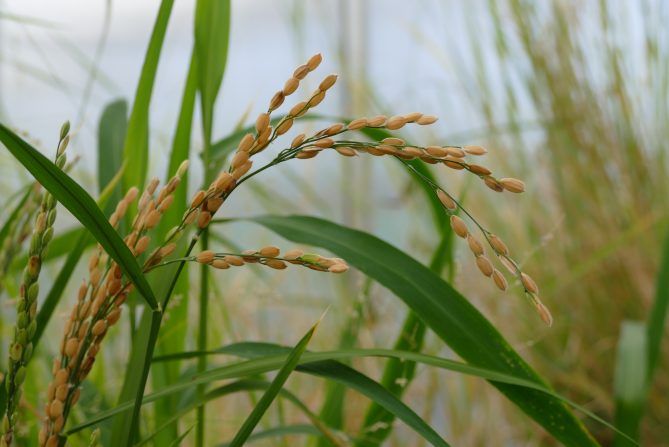Australia
November 20, 2020

An international long-term research collaboration aimed at creating high yielding and water use efficient rice varieties, has successfully installed part of the photosynthetic machinery from maize into rice.
Rice, one of the main world food staples, uses the less efficient C3 photosynthetic pathway. Scientists predict that the introduction of the more efficient C4 photosynthesis traits into rice can potentially increase photosynthetic efficiency by fifty percent, improve nitrogen use efficiency and double water use efficiency.
“We assembled five genes from maize that code for five enzymes in the C4 photosynthetic pathway into a single gene construct and installed it into rice plants,” said lead author Dr Maria Ermakova, who works at The Australian National University (ANU), as part of the international C4 Rice Project, led by Oxford University.
“Although introducing all the genes required to make C4 rice still a long way off, this is the first paper where we assembled a functional C4 biochemistry in rice, which is very exciting,” said Dr Ermakova, from the ARC Centre of Excellence for Translational Photosynthesis (CoETP).

l-r: Professor Robert Furbank, Dr Maria Ermakova and Dr Florence Danila with rice in the glasshouse
Using synthetic biology, scientists can introduce several genes at the same time, get a plant in just a year and make prototypes to redesign their “constructs” very rapidly, just in a matter of months. In sharp contrast, using to the old approach, which inserts one single gene each time, can take several years.
“For me, the most important aspect of this paper is that we have mastered the technology that will help us in our journey towards C4 rice and now we can move forward to the next phase at a higher velocity than ever before,” said CoETP’s Deputy Director Professor Susanne von Caemmerer, one of the co-authors of this study.
Using the same kind of technique that Hal Hatch used in 1966 during the discovery of the C4 pathway, the team of researchers from the Max Planck Institute were able to follow the labeled CO2 on its way through the pathway.
‘This is another key result, as we were able to prove that carbon dioxide is fixed using the C4 pathway. In other words, we achieved gene expression, but we also got the enzymes involved to be active and functioning in the plant in the right cells,” says Professor von Caemmerer.

Co-autors of the paper, Professor Robert Furbank and Professor Susanne von Caemmerer.
“Even though the plants we produced are not yet working very efficiently as C4, we now know that part of their photosynthesis is moving through the C4 pathway,” she says.
“The research team include scientists with diverse expertise from microscopy to physiology, plant breeding and modelling” says Dr Florence Danila, who was in charge of the enzyme localisation using molecular microscopy techniques at the ANU C4 Rice Project Node.

What does it take to be C4? Credit: Carl Davies
“We started the C4 rice project ten years ago, involving sixteen labs in eleven countries. This particular research has taken us five years to complete, and the coordinated effort of several researchers from multiple organisations around the world, including Washington State University, Oxford University, Cambridge University, ANU and the Max Planck Institute,” says Professor Robert Furbank, Director of the ARC Centre of Excellence for Translational Photosynthesis and one of the authors of the study.
“Our next step is to assemble a construct using sixteen genes, so we have lots of work to do. These are the first wobbly steps towards achieving C4 rice. These results show that we can manipulate a whole metabolic pathway. These results show that creating a functional C4 rice is possible,” Professor Furbank says.
The C4 Rice Project consortium comprises the Academia Sinica, Australian National University, Max Planck Institute of Molecular Plant Physiology, Leibniz Institute of Biochemistry, University of Cambridge, University of Oxford and Washington State University and is funded by a grant from the Bill & Melinda Gates Foundation to the University of Oxford.
This research has been partially funded by the ARC Centre of Excellence for Translational Photosynthesis, which aims to improve the process of photosynthesis to increase the production of major food crops such as sorghum, wheat and rice.
The paper was published in the Plant Biotechnology Journal and is available to view online at https://onlinelibrary.wiley.com/doi/full/10.1111/pbi.13487 Read here